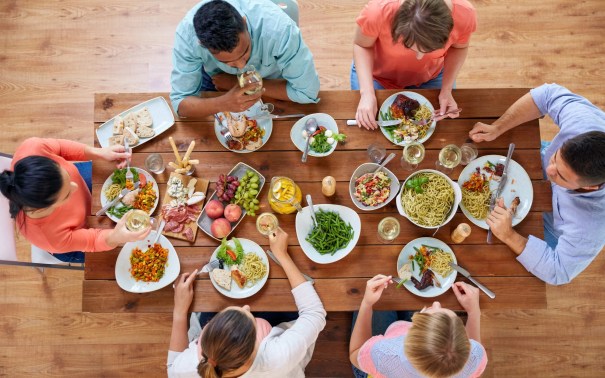
Eating slowly is a key strategy for managing your weight. Yes, I can see the eye rolls and hear the long sighs at the mention of losing weight or managing your weight. But, as I mentioned in a previous post on planning for weight loss success, losing weight is the number one thing that women ask me about as a registered dietitian nutritionist. Additionally, women search online for information on weight loss more than any other health topic.
However, as you know, I do not recommend any particular weight loss diet. But, I do recommend strategies that empower and build confidence. And, learning to eat slowly, regardless of whether it is an apple for a snack or a full-course meal, is a game-changer for losing weight.
So, let’s begin with answering these questions:
- Do you eat too fast most of the time?
- Have you ever looked up from your plate or stuck your hand in an empty bag of chips and wondered where all the food went?
- Do you feel like you’re always shoveling food into your mouth rather than eating it?
- Do you ever finish a glass of juice, milk, or whatever in three big gulps?
If you answered yes to any of these questions, then you have a problem with eating too fast. However, you are not alone. According to the United States Department of Agriculture’s Department of Economic Research, we spend less time eating than we did a decade ago. And, I will address those reasons in another post. However, today, I will tell you why eating slowly should be one of your SMART weight loss goals, and provide some tips on how to do so.

Benefits of Eating Slowly
So, eating slowly has many health benefits.
First, your foods taste better. In fact, when you have more time to eat, you experience more of the smells, taste, and textures of each food in the meal.
Second, your digestion improves. Indigestion, heartburn, and gassiness usually result from eating too fast. Thus, eating slower allows your digestive system to do its job well.
Third, you eat less food because your stomach feels full sooner. Yes, this is actually a thing. So, it takes about 20 minutes for your digestive system to send a signal to your brain to say that it has had enough. And, chewing slower, taking sips of water, and waiting 20 minutes gives you enough time to feel full.
Choose a Meal or Snack to Practice
Learning to eat slowly will take practice because breaking the habit of shoving food quickly in your mouth is hard. So, pick a meal to practice. Or, instead of a meal, practice with an afternoon snack.
For example, start with an apple. Cut the apple into slices and practice eating each piece slowly. Listen to the crunch of the apple, and feel the sweet juices explode slowly in your mouth. Repeat with each slice. And, of course, you can learn to take smaller bites if you prefer not to cut it.
Or, you can practice with a cup of yogurt. Remove the lid slowly, take small a spoonful, and swirl it in your mouth before swallowing. Repeat.
And, after practicing with apple slices or yogurt, then, move on to practicing with a small amount of nuts or blueberries. Yes, try eating one or two at a time rather than tossing a handful into your mouth. So, it all boils down to this. Mastering eating an apple, a cup of yogurt or a small amount of nuts slowly helps with eating larger meals. Oh, and the same thing goes for drinking a protein shake or smoothie.
Minimize Distraction
Well, I am sure that you know about distracted driving. In fact, because of the large number of accidents and deaths, many cities and states ban distracted driving. But, what about distracted eating? While not on the same danger level as distracted driving, distracted eating causes us to each too much and contribute to weight gain or inability to lose weight.
And, I am sure you agree that we multitask too much while we eat. So, we eat while we drive, watch TV, scroll on our tablets or phones, and work at our desks. Additionally, scientific evidence links distracted eating to obesity. In fact, a systematic literature review of 24 research studies found that limiting distraction and being mindful of what is eaten aid weight loss and maintenance. And, the best part is that you can do this without counting calories. Now, that is great news.
So, please make an effort to turn off or put away distractions while you eat. On a practical level, this means eating at the table and talking to friends and families while you eat. Believe me, this is a hard one for me, especially since I tend to eat lunch while working at my computer work. But, I make the effort to take small breaks to eat and enjoy my meals.
Set a Timer
Now, I can almost hear you thinking, “Dee, how much time should I spend eating?” And, “Why do I need a timer?” Well, it depends on the meal and how much time you realistically have to eat.
So, I recommend setting aside 10 minutes to practice eating a snack slowly, and 20 minutes to practice eating a meal slowly. Again, I realize this requires some effort, but go ahead and set the timer on your phone. Go!
Put Down Your Eating Utensils
Many people spend the entire time mealtime with a fork in their hand. In fact, they only put it down to grab a piece of bread, take a sip of a drink, or scroll on their phones. Does this sound familiar?
So, I want you to put down your eating utensils (knife, fork, or spoon) after you put the food in the mouth.
- Chew your food
- Count to ten
- Pick up your utensil
- Put food in your mouth
- Repeat
Again, this requires effort and practice, but hang in there.
Drink Water Before and During Meals
Drink a glass of water before you eat a meal, and take sips after every few bites. No, water doesn’t offer any magical weight-loss power, but sipping water will slow down your eating.
Now, I can hear some of you saying, “Dee, you shouldn’t drink water while you eat?” Really? You sound like my mother, “Drinking water will spoil your appetite.” Yes, and that is exactly what you want to do when you’re trying to lose weight or slow down your eating. And, by the way, drinking water during a meal does not dilute your digestive juices or interfere with digestion. In fact, it helps digestion.
Practice with Someone
Well, chances are you know someone who can also benefit from eating slowly. And, as you know, accountability works. So, ask a friend, coworker, family member, or exercise buddy to practice eating slowly with you.
Teach Children to Eat Slowly
So, bear with me on this one. As you know, children model what they see and learn what we teach them. Specifically, parents and schools teach children to eat fast. I have seen parents or caregivers fuss at and yell at children for eating slowly. They say things like, “Hurry up and eat, we’re in a hurry.” “You always eat so slowly.” And, then, threats or more yelling and fussing follow.
And, parents are not the only one. Studies show that schools do not give children enough time to eat. And, remember, part of those 20 to 30 minutes at lunch is spent in the lunch line and finding a place to sit. And, that’s a problem for several reasons:
- Children get hungry when they don’t get enough time to eat
- Like adults, children who eat too quickly are more likely to gain too much weight
- Foods are not savored, and children don’t enjoy mealtimes
- The less time children have to eat means that they have less time to eat the healthy foods on the plate
- Food is wasted and thrown in the trash because children do not finish the meals
And, you don’t want to miss this part. Kindergartners are more likely to be impacted. Yeah. Imagine wanting to take a nap, eating apple slices with a missing baby tooth, and not having enough time to eat. Long sigh. So, give your children enough time to eat when they are at home, and teach them that it is OK to eat slowly.
Now, It’s Your Turn
Well, I hope you feel more confident and educated about the importance of eating slowly for weight loss and for overall health and well-being. Additionally, I think you will also enjoy the blog post on fad diets and 10 common weight loss myths and 12 tips for sticking to your meal plan at restaurants.
- On a scale from 1 to 10, how fast do you eat?
- Identify at least 2 tips for eating slowly that you will try.
- Set aside 20 minutes today to practice eating slowly.
Well, we look forward to hearing about your experience in the comment section of this blog. And, you can join the conversation on the Keep It Tight Sisters Facebook Page.
If you enjoyed this post, please share it on your page or social network. Your subscription to the blog is also appreciated!
We also have more than 70 self-care boards for you to follow on Pinterest.
Keep It Tight Sisters.
Eat. Move. Breathe.